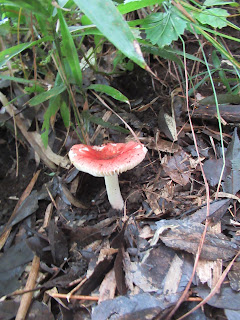The other day this month, I happened to have an occasion to have lunch with Dr. Toshimitsu Fukiharu and his wife of Natural History Museum and Institute of Chiba Prefecture 千葉県立中央博物館. They are experts for fungi. Dr. Fukiharu said, “This is a strange year. The amount of precipitation is fluctuating wildly in Chiba. Summer and early autumn were dry … In early September we had just one day downpour but basically the rest was for tiny droplets, if any.” His wife added. “So, when we’ve been to forests searching for fungi, we could find only a small number of specimens. Now it’s November and the season for mushroom hunting is over for 2023. How was it in Kanagawa?” So, I told them my adventure in West Tanzawa 西丹沢 early October: it was the same here in Kanagawa (my post for October 13).
Yap, this year we have had below average rain drops, but amount-wise for a year it’s not so bad both in Kanagawa and Chiba. But when we see the monthly and daily changes …
 |
| The way droplets came was like “continuous dry days, and a day or two downpour.” Japan was not like that before … |
 |
| Purple-bloom
russula (Russula mariae) in yesteryears |
 |
| But
this year, purple-bloom russula (Russula mariae) only. Huh, both are beautiful for sure. |
 |
| Actually,
this has been a bumper year for flowering mycoheterotrophic orchids in Yokohama. It is Lecanorchis nigricans in November. They have completed their fruition. |
Meanwhile, in the forests of Kanagawa Prefecture where oak tree wilt is rampant, lots of hard ear mushrooms stick from the dead trunks. I think it’s a normal ecological succession where infectious disease kills trees … Still, is it only because of me? I feel uneasy something …
657 Nanasawa, Atsugi City, 243-0121
〒243-0121 厚木市七沢657
Phone: 046-248-0323
You can send an enquiry to them by clicking the bottom line of their homepage at http://www.pref.kanagawa.jp/div/1644/




























































